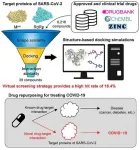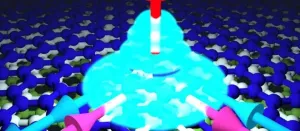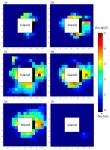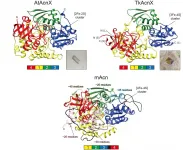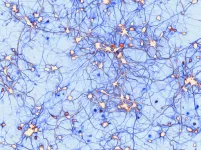NIH researchers expand Families SHARE, an educational genomics workbook
Study shows 70% of people who use the workbook discuss their disease risks and health history with family members
2021-07-08
(Press-News.org) Researchers at the National Human Genome Research Institute (NHGRI), part of the National Institutes of Health (NIH), have developed the Families Sharing Health Assessment and Risk Evaluation (SHARE) workbook, which helps people use their family history to assess their risk for heart disease, diabetes, breast cancer and colorectal cancer.
Since 2012, Laura Koehly, Ph.D., and her research team have measured the accessibility and usability of the workbook by working with communities and continually updating the workbook to address issues. Koehly is the chief of the Social and Behavioral Research Branch at NHGRI and senior author of the study. In a recent study in the journal Public Health Genomics, the researchers published data gathered from questions on the efficacy of the workbook that they posed to African American communities.
Through the Families SHARE workbook, researchers seek to provide a tool that encourages people to have discussions about their family health history and helps them understand how their family history is associated with their risk for heritable diseases. The workbook also provides feedback on the ways people can reduce their risk for diseases, such as changing their behavior and seeking clinical care.
African Americans experience a disproportionately high number of chronic diseases compared to other racial and ethnic groups in the United States. African American families are also exposed to social and environmental health risks that are known to contribute to higher diabetes and heart disease rates.
"One big issue is that many available genomics resources don't reach a vast number of people," said Koehly. "For this study, we wanted to evaluate if the Families SHARE workbook could bridge that gap and whether it is well-adapted as a tool for low-income African American families."
The research team collected data from African American adults living in two low-income neighborhoods in Baltimore and Washington, D.C. During a baseline survey, the researchers captured data about the individuals' family health history and health status.
The researchers gave the participants Families SHARE workbooks, which included:
Personalized family trees associated with heart disease, diabetes, breast cancer and colorectal cancer.
Definitions of each disease and associated risk factors.
A worksheet that explains how clinicians assess increased risk based on family health history.
A set of additional tools to remind participants to make healthy lifestyle choices based on their level of disease risk, and to remind them to update their family health history.
Six weeks after receiving the workbook, participants noted a sense of ownership over their family health history. Ninety-eight percent of participants reported that they could assess their own disease risk when using the workbook, and 70% of the people had shared the workbook with their family members and also tried to assess the family members' disease risk. Three-quarters of the participants felt motivated to share it with others, like healthcare providers, in the future.
"It was incredibly valuable to see the start of a dialogue between family members about their health history," said Kayla de la Haye, Ph.D., associate professor of preventive medicine at the University of Southern California and corresponding author on the study.
Based on discussions during focus groups with participants, the researchers plan to include community education programs in future iterations of the workbook.
"Our participants are telling us that they want advocates to help them use and understand the workbook in a community setting. They want a support system where community members can come together to learn from one another," Koehly said. "Our future efforts will take these suggestions into account."
Apart from the workbook for African Americans, the researchers are also working with domestic and international communities to design other versions of the workbook for diverse groups.
INFORMATION:
ELSE PRESS RELEASES FROM THIS DATE:
2021-07-08
A joint research group from KAIST and Institut Pasteur Korea has identified repurposed drugs for COVID-19 treatment through virtual screening and cell-based assays. The research team suggested the strategy for virtual screening with greatly reduced false positives by incorporating pre-docking filtering based on shape similarity and post-docking filtering based on interaction similarity. This strategy will help develop therapeutic medications for COVID-19 and other antiviral diseases more rapidly. This study was reported at the Proceedings of the National Academy of Sciences of ...
2021-07-08
Washington, DC (July 6, 2021) --The International Whaling Commission (IWC) was founded to regulate whaling. Today, it also increasingly focuses on the value of live whales for planetary health. A new workshop report confirms the great ecological value of whales to help mitigate climate change, transport nutrients, enhance marine productivity, and promote biodiversity in marine ecosystems.
The world's leading experts gathered for a three-day workshop in April that was co-hosted by the IWC and the Convention on the Conservation of Migratory Species of Wild Animals (CMS). The meeting came in response to a 2016 IWC resolution, introduced by the government of Chile, to compile scientific information about the ecological roles of cetaceans (whales and dolphins).
The workshop discussions ...
2021-07-08
Researchers at the National Cerebral and Cardiovascular Center in Japan show that excessive blood pressure reduction for acute intracerebral hemorrhage is risky in people with decreased kidney function
Suita, Japan -- Stroke and chronic kidney disease are both difficult to handle in their own rights, but having a stroke when your kidneys are already poor is more than just double the trouble. A new study led by Kazunori Toyoda at the National Cerebral and Cardiovascular Center (NCVC) in Japan shows that excessive blood pressure reduction for acute intracerebral hemorrhage can have dire consequences when kidney function is low. The study was published in the scientific journal Neurology®.
Intracerebral hemorrhage is a disease for which effective treatment is expected ...
2021-07-08
Rare-earth compounds have fascinated researchers for decades due to the unique quantum properties they display, which have so far remained totally out of reach of everyday compounds. One of the most remarkable and exotic properties of those materials is the emergence of exotic superconducting states, and particularly the superconducting states required to build future topological quantum computers. While these specific rare-earth compounds, known as heavy fermion superconductors, have been known for decades, making usable quantum technologies out of them has remained a critically ...
2021-07-08
A new study suggests sea discoloration data obtained from satellite images as a novel criterion in predicting if eruption looms for an underwater volcano.
There have been frequent eruptions of submarine volcanoes in recent years. The past two years alone recorded the explosions of Anak Krakatau in Indonesia, White Island in New Zealand, and Nishinoshima Island in Japan. Observing signs of volcanic unrest is crucial in providing life-saving information and ensuring that air and maritime travel are safe in the area.
Although predicting when a volcano will erupt can be difficult as each behaves differently, scientists are on the lookout for these telltale signs: heightened seismic activity, expansion of magma pools, increases in volcanic gas release, ...
2021-07-08
A pioneering cultivation strategy that recreates a mangrove environment in the lab has enabled identification of novel bacteria residing in Red Sea mangroves and will help improve understanding of mangrove ecosystem stability, resilience and sustainability.
Mangroves are highly productive, dominant coastal ecosystems that line between 60-70 percent of the world's tropical and subtropical coastlines. They harbor diverse microbial communities thought to make up 80 percent of the ecosystem's biomass. Many of the microbial species, families and taxa are unknown to science.
The cultivation strategy was developed by a team of KAUST researchers, including Fatmah Sefrji and Ramona Marasco.
"Red Sea mangroves are particularly interesting because they represent an extreme and unique ...
2021-07-08
The aconitase superfamily currently contains four functional enzymes including the archetypical aconitase (referred to as "other aconitase enzymes"), and one hypothetical aconitase X (AcnX). The aconitase enzymes catalyze the homologous stereospecific isomerization, and their three-dimensional structures and catalytic mechanisms including the [4Fe-4S] iron-sulfur cluster are very similar each other (Fig. 1a). Therefore, the aconitase superfamily (enzymes) is a typical example that is suitable for the so-called "recruitment hypothesis of enzyme evolution"; the gene duplication of multi-specific enzymes, followed by the narrowing of substrate specificity (ref. 1).
AcnX (subfamily) is further classified into "AcnXType-I" consisting of a single ...
2021-07-08
Researchers at The University of Queensland, working to gain a better understanding of how brain cells work, have discovered the underlying mechanism of a rare genetic mutation that can cause epilepsy.
Dr Victor Anggono from UQ's Queensland Brain Institute said his team made the ground-breaking findings while researching nerve cell communications, which are an important process in normal brain function.
''We're both excited and astounded to make such an important contribution to the field of cellular and molecular neuroscience,'' Dr Anggono said.
He stressed that the mutation was extremely rare, with only one reported case in the world to date.
Dr Anggono's team studied protein structures, called receptors, that ...
2021-07-08
A study by researchers in the Scene understanding and artificial intelligence (SUNAI) research group, of the Universitat Oberta de Catalunya's (UOC) Faculty of Computer Science, Multimedia and Telecommunications, has developed a method that can learn to identify mosquitoes using a large number of images that volunteers took using mobile phones and uploaded to Mosquito Alert platform.
Citizen science to investigate and control disease-transmitting mosquitoes
As well as being annoying because of their bites, mosquitoes can be the carriers of pathogens. Rising temperatures worldwide are facilitating their spread. This is the case with the tiger ...
2021-07-08
While the UK was in lockdown, certain species of captive amphibians became more visible, a new study suggests.
The COVID-19 pandemic forced the closure of zoos across the UK for several months from March 2020, with gradual re-openings from summer into autumn and winter.
These closures provided a team of researchers, from the University of Exeter and WWT Slimbridge Wetland Centre, a unique opportunity to study the effect of visitor presence on several species of amphibian at Slimbridge.
The project assessed the number of individuals of six species - common toad, common frog, smooth newt, pool frog, golden mantella and golden poison dart frog - visible to observers while their exhibit was closed, when it partially reopened to more staff and when it reopened to visitors.
"Amphibians ...
LAST 30 PRESS RELEASES:
[Press-News.org] NIH researchers expand Families SHARE, an educational genomics workbook
Study shows 70% of people who use the workbook discuss their disease risks and health history with family members
